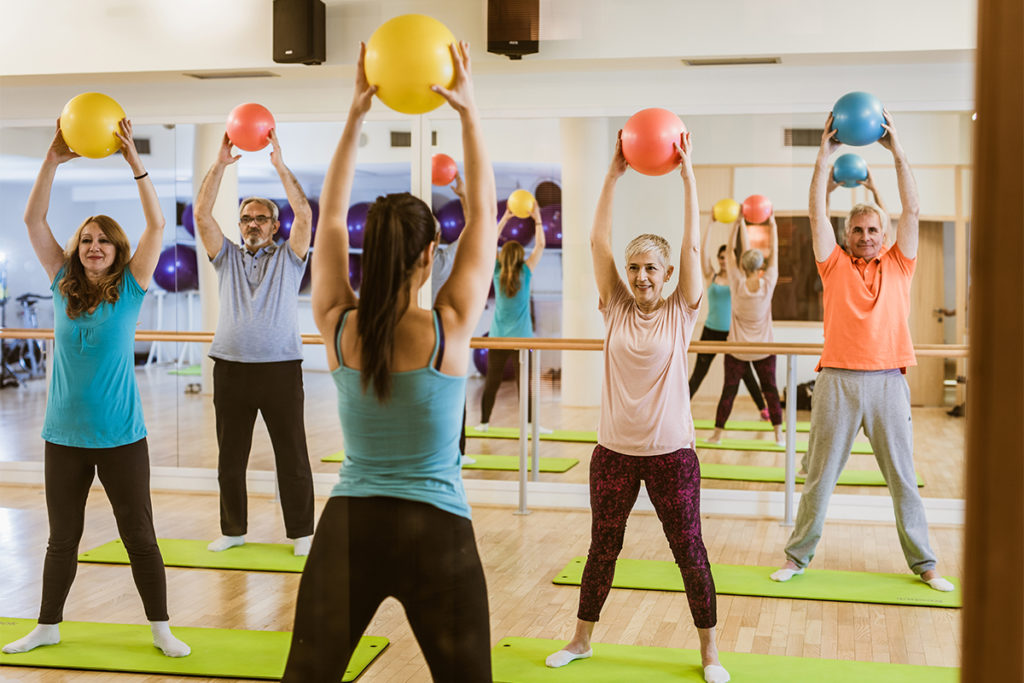The Four Pillars ofHuman Movement
IDEA PERSONAL Trainer February 2002IDEA PERSONAL Trainer February 2002 The Four Pillars of Human Movement
“Functional training” is probably the most red hot, albeit misused, phrase in the fitness and conditioning industry today. It is not only the buzzword, it appears to be the trend of choice for exercise program design.
Ever since different-looking exercises such as single-leg reaches first appeared and were called functional, it seems that any strange-looking new exercise also gets passed off under this description. But just because it looks different and is difficult to perform does not make it functional.
As with any trend, functional training has its good and bad points. On the positive side, it presents an exciting alternative for those wishing to exercise and train for performance. Although functional training has been around for about 30 years, it simply was not popular until recently. Today, you’re considered a Neanderthal if you have not at least dabbled in it! However, there is a price to pay for progress, which points to the down side of this trend: Functional training has been mystified, complicated, and to some degree, ill-defined. To that end, let’s begin with
a definition.
Function is a specific duty or purpose of a person or thing. What is the function of the human body? The main duties of the body are to provide structure and movement. Therefore, functional training is any program or exercise that enhances the body’s structure and/or movement. With respect to structure, the body requires a strong skeletal and muscular system for proper function. Exactly how big and strong depends on what secondary function one has chosen to participate in.
A young football player and a 70-year-old grandmother both need to be strong, but in varying degrees and for different reasons. Although the type of training and approach needed for improved structure may be the same (e.g., hypertrophy) the process and final product will look a bit different.
The similarities between our distinctly different client examples don’t end with training approach. When we focus on movement and the structure of the human body, we discover that the
football player and grandmother have much in common. They have the same number of bones and muscles, the same anatomical landmarks and the same biomechanics. In fact, all humans have the same basic body structure with the same movement function. We all do the following:
1. We stand or locomote.
2. We raise and lower our centers
of mass.
3. We push or pull.
4. We rotate.
These are the four pillars of human movement, all major categories of biomechanics that the human body is built to perform. The methodology to train each pillar is the same for everyone. Apart from the obvious genetic factors, it’s the process (intensity, frequency and duration) and level of achievement (strength, power, speed and skill) that differentiate one person from another.
Try to compare training the four pillars with the example of feeding the same foods to different people: Although everyone may eat the same turkey sandwich and ingest it in the same way, each person might eat
a different amount and experience a different result (weight, energy stored). To better understand such a comparison, let’s look more closely at
each pillar.
The first pillar, standing and locomotion, simply points out that humans are bipedal animals. This means we stand, walk and run on two feet. Much of the standing we do also supports other movements such as pushing, pulling or rotating. This means the first pillar rarely exists symmetrically “loaded” or supported by a perfectly balanced stance (feet parallel, planted firmly).
Locomotion is of great importance in our lives. It defines most popular sports and its absence is associated with a decline in quality of life. This pillar puts our feet on the ground, generally one foot at a time. It allows us to produce force and precedes most human movement. In essence, this first pillar defines ground-based force production and locomotion, and provides the foundation of human function.
This pillar is focused on lowering and raising one’s center of mass. The body accomplishes this task by using the lower body for squatting, lunging and stepping. We also can raise or lower our centers of mass by flexing or extending the trunk. In real-life situations we normally use both movements in combination. For example, we lunge and flex our trunks to tie our shoes or catch a ground ball.
The second pillar is distinctive in that it allows us to neutralize and utilize gravity. It takes minimal energy to reach down to tie our shoes or lower the body to catch a ground ball, as gravity greatly assists us in both examples. Although it appears that the trunk flexes to perform each of these movements, we don’t actually flex with the abdominals. Likewise, although we bend our knees when we kneel down, our hamstrings don’t bend the knees. Again, it’s gravity that lowers the body by flexing the knees and trunk.
Therefore, in terms of function, the second pillar is loaded by gravity. This loading is essential for powerful movements, such as jumping and running. Just think, without gravity there would be no stretch reflex, and therefore, no plyometric movements. Without gravity, you could not effectively load the musculature that is involved in jumping or running. For these reasons, training this pillar in a dynamic fashion becomes a primary objective of functional training.
The third pillar is primarily focused on the movements of the upper extremities. Basically, we either push or pull with the upper body. To put this simply, a push moves the hand away from the body and a pull brings the hand towards the body.
Pushing involves primal reflexes involved with hunting, self-preservation and defense. Pulling involves our gathering function and includes carrying objects and picking up things off the ground. Many actions encompass both pushing and pulling, such as sawing and throwing.
Training this pillar can take on many different forms. Since we usually are standing when we push or pull on something, training this pillar functionally involves linking movements with the first two pillars. The net effect is that we push and pull from many different standing positions and utilize many different motions, such as rotation, when training these positions.
The fourth and final pillar involves all rotational movements. By far, this pillar is the most important of the four described in this article. One look at our muscular design clearly illustrates why everything we do with power involves rotational forces, even in movements that appear to be linear, such as running and walking. Our core musculature is designed in a crisscross pattern called the serape effect. This means that it produces force by connecting the right shoulder to the left hip and vice-versa.
As you can see, the musculature involved in the serape effect connects the body in a diagonal manner, making the core very efficient when performing powerful rotational movements.
Powerful activities, such as throwing, swinging and running are possible because of the serape effect. Therefore, when trying to enhance the body’s natural rotational design, training must address the transverse plane of motion. As with the other pillars, rotation rarely occurs in isolation. Usually, the rotation is amplified by hip and leg motion. This is the primary reason we prefer the standing position in exercises, especially when training rotational movement.
As you can see, looking at the four pillars of human movement as a programming model can serve as a simple path to exercise and program design. The four pillars provide a simple and singular approach to training the human body, regardless of the population being addressed. This “human-specific model” leads us into specificity training.
Specificity of training dictates that you get what you train for. That is, “there are specific adaptations to the imposed demands of training,” otherwise known as the SAID principle. This means you don’t achieve power by running a marathon and you don’t achieve cardiovascular fitness by performing a few one-repetition max exercises. No one has become more familiar with the concept of specificity than those in the sports conditioning world. The concept of sport-specific training is a common marketing description in many sports conditioning programs. Although sporting events do differ from one another and are different than daily activity, the four-pillars model fundamentally challenges and simplifies the concept of sport-specific movement training.
If we follow the general observations of the four pillars, then we can agree that humans are fundamentally made the same way and we accomplish biomechanical tasks in the same fundamental manner. Apart from the obvious genetic factors, it’s the process (intensity, frequency and duration) and level of achievement (strength, power, speed and skill) that differentiate one person from another.
This observation can be followed by another: All sports are designed around what the human body can accomplish —not the other way around. We don’t change the function of the body to accomplish a sporting task. In other words, no sports require us to hold a bat with our feet, turn our heads 360 degrees or run on our knees. Why? Because these functions are not “human specific.” If the body can’t do it, there
is no sport!
Outside of a few specialized sports such as Olympic weightlifting and rowing, most sports are based on the four pillars of human movement. In my opinion, sport-specific movement training, especially at the developmental level, is more a marketing idea than a training methodology. The four pillars provide a movement approach to training, not an aesthetic approach to performance. If you train using the basics of the four pillars, you automatically enhance athleticism, because athleticism is fundamentally the ability to integrate the four pillars.
For example, although they move at different speeds and amplitudes, a grandparent and a professional athlete are generally built and move in the same manner. Thus, their programs should address the same four pillars—just using different speeds and amplitudes. Each of these clients will train with as much weight as they can safely handle (strength); move moderate loads as fast as safely possible (power); create appropriate fast movement action/
reactions (speed); and train appropriate complex movements (skill). They will do all of this within their relative
abilities, distinguished by various
physiological parameters. The outcome will look much different across various populations, but the approach remains the same. Remember, it’s all about the fundamental movement of the human body.
and Success
Using a movement approach to training and program design makes life simple. My success and effectiveness hinges on my ability to keep things simple and usable. I often have to change gears in minutes. I may work with a 65-year-old female from
10:00 AM to 11:00 AM, then train a professional athlete from 11:00 AM to noon. If I were forced to have 50 different training approaches for the 50 clients I may service in a week, I would be overwhelmed.
The four-pillar approach allows me to concentrate on the movements we all perform. The 65-year-old female will just perform those movements a little slower, through a shorter range
of motion, with lighter loads and with more recovery time than the professional athlete. This is a model I can use every day; it has allowed me to “live”
a little bit more by making my work
a little simpler. I hope it does the same for you. l
Training the first pillar
IDEA PERSONAL Trainer February 2002
Training the second pillar
IDEA PERSONAL Trainer February 2002 The Four Pillars of Human Movement
IDEA PERSONAL Trainer February 2002
This figure shows the musculature involved in the serape effect.
Rhomboids
Serratus
External Obliques
Internal Obliques
Training the fourth pillar
IDEA PERSONAL Trainer February 2002 The Four Pillars of Human Movement
Here is an example of how the same training approach can benefit two distinct populations.
Working the first and second pillars—Anterior Reach
Working the third and fourth pillars—Alternating, Rotational Band/Pulley Pulls
These two exercises provide a glimpse at how the same training approach can be used for all populations, regardless of performance needs. Using the movement approach of the four pillars automatically takes care of the “specificity issue” of movement training, since no functional activity can violate the four-pillar model (e.g., no functional activity can require us to rotate our heads 360 degrees). The tweaks available to coaches and trainers can then create various progressions to fit the training and execution level of any individual.
General Notes:
The anterior, single-leg reach is an excellent exercise for improving leg and hip strength, gait, balance and deceleration mechanics.
It can be performed in various ways. The photos demonstrate a contralateral reach.
Exercise Execution:
Technique Progression:
The progression for any standing exercise is the following:
Fine Tuning:
We also use three basic “tweaks” to increase the difficulty of this and other exercises.
Additional Tips:
General Notes:
The alternating, rotational band/pulley pull provides functional, ground-based, upper-body training. It combines pillars three
and four.
Exercise Execution:
Technique Progression:
IDEA PERSONAL Trainer February 2002Although they move at different
IDEA PERSONAL Trainer February 2002 The Four Pillars of Human Movement IDEA PERSONAL Trainer February 2002
References
Logan, G., & McKinney, W. 1970. The serape effect. In Anatomic Kinesiology (2nd Ed., pp. 154-561). New York: William C. Brown, Co.




